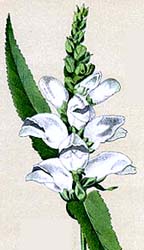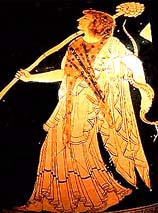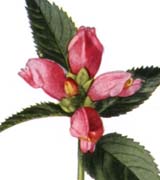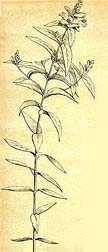 Chelone glabra Chelone glabra
Turtlehead
This handsome plant is named after the Greek nymph, Χελωνη
(Khelone), who was punished because she didn't want to go to the
wedding of Zeus and Hera. In one version, she laughed at the very idea of these
two marrying,
and in another, she said she just preferred to stay home. She was
changed into a tortoise, which has no voice and carries its home on its
back. Chelone was one of the Oreiades (nymphs of mountain pines), who
were followers of Aphrodite. The most famous is Echo, who was also
deprived of independent speech, this time by Hera. The Oreiades were
the children of what we would think of as male and female gnomes:
beings who discovered iron and invented smelting. The Oreiades are
often depicted carrying a large staff topped by a pine cone and
carrying a snake, both phallic symbols. We wonder if this story is
really about the silencing and dispersing of more ancient nature
deities by the Olympian gods. Top
 Because of its affinity for water, most
would consider this a Neptune herb, but it can be aligned with
Water in honor of its association with a much older set of deities
than those represented by the known planets. It is good for working
with Turtle as the power animal, for works involving tenacity and
persistance, and as protection for
wanderers. One type of magic done with this plant is that an enemy's
name is written on the leaves and they are wrapped up to make the
person become sick. Turtlehead is also burned to cause harm to another.
but it seems surprising that this plant would be used in this way, since it
is not poisonous, and most baneful magic is associated with
baneful herbs. In Hoodoo, turtlehead is known as snakehead; its root is
a powerful protective herb, put into personal charm bags (mojo bags) and hung in
the car or home for protection. Top Because of its affinity for water, most
would consider this a Neptune herb, but it can be aligned with
Water in honor of its association with a much older set of deities
than those represented by the known planets. It is good for working
with Turtle as the power animal, for works involving tenacity and
persistance, and as protection for
wanderers. One type of magic done with this plant is that an enemy's
name is written on the leaves and they are wrapped up to make the
person become sick. Turtlehead is also burned to cause harm to another.
but it seems surprising that this plant would be used in this way, since it
is not poisonous, and most baneful magic is associated with
baneful herbs. In Hoodoo, turtlehead is known as snakehead; its root is
a powerful protective herb, put into personal charm bags (mojo bags) and hung in
the car or home for protection. Top
 Cherokee drank the bitter infusion of this plant's leaves for worms, to
increase
appetite, for fevers, and as a laxative. They also parboiled the young
shoots and leaves, rinsed them off, and then panfried them to eat
(probably a famine food). The Iroquois drank a tea of turtlehead as a
protection against witchcraft, and the Algonquin made a medicinal tea
of this plant combined with cedar bark. European Americans once used
turtlehead in very small amounts as a laxative and tonic purgative,
as an antidepressant, for people recovering from fevers, and as a
bitter tonic for the liver and gallbladder. In the past, 1 teaspoon of
dried herb was steeped in 8 oz water for one hour, and half of this was
drunk before meals to increase the metabolism of fats and other
hard-to-digest foods. It is harvested when flowering. This native to eastern North America is also known as balmony, white turtlehead, turtle bloom, fishmouth, codhead,
salt-rheum weed, snakehead, bitter herb, shellflower, and Chelone obliqua. Top Cherokee drank the bitter infusion of this plant's leaves for worms, to
increase
appetite, for fevers, and as a laxative. They also parboiled the young
shoots and leaves, rinsed them off, and then panfried them to eat
(probably a famine food). The Iroquois drank a tea of turtlehead as a
protection against witchcraft, and the Algonquin made a medicinal tea
of this plant combined with cedar bark. European Americans once used
turtlehead in very small amounts as a laxative and tonic purgative,
as an antidepressant, for people recovering from fevers, and as a
bitter tonic for the liver and gallbladder. In the past, 1 teaspoon of
dried herb was steeped in 8 oz water for one hour, and half of this was
drunk before meals to increase the metabolism of fats and other
hard-to-digest foods. It is harvested when flowering. This native to eastern North America is also known as balmony, white turtlehead, turtle bloom, fishmouth, codhead,
salt-rheum weed, snakehead, bitter herb, shellflower, and Chelone obliqua. Top
 How to grow
Turtlehead: Sow in spring, barely covering, to germinate in 2-6 weeks at 68F/20C.
Transplant to rich soil amended with plenty of compost and partial
shade--it can get floppy in dense shade. Turtlehead likes to grow
around likes stream banks, ponds, ditches, and damp ground. It can get
mildew if it doesn't have enough water or enough air circulation. It
gets up to 4.5ft/1.5m tall. This is a variable plant: its flowers can
be white, tinged with purple or pink, totally pink or totally purple.
It blooms late summer through fall. The flowers don't have a scent, but
butterflies like them. This is a perennial in zones 3-8 (down to ),
that is, throughout much of North America, excepting the hottest parts.
Turtlehead spreads by creeping rhizomes. Once you get it started, you can make more by rooting
cuttings in sand. Divide thick clumps of it in the fall. Bitter leaves
make this a deer-resistant plant. General growing
info Top How to grow
Turtlehead: Sow in spring, barely covering, to germinate in 2-6 weeks at 68F/20C.
Transplant to rich soil amended with plenty of compost and partial
shade--it can get floppy in dense shade. Turtlehead likes to grow
around likes stream banks, ponds, ditches, and damp ground. It can get
mildew if it doesn't have enough water or enough air circulation. It
gets up to 4.5ft/1.5m tall. This is a variable plant: its flowers can
be white, tinged with purple or pink, totally pink or totally purple.
It blooms late summer through fall. The flowers don't have a scent, but
butterflies like them. This is a perennial in zones 3-8 (down to ),
that is, throughout much of North America, excepting the hottest parts.
Turtlehead spreads by creeping rhizomes. Once you get it started, you can make more by rooting
cuttings in sand. Divide thick clumps of it in the fall. Bitter leaves
make this a deer-resistant plant. General growing
info Top
|
Chelone glabra
Turtlehead
150 seeds $3.95

Uses in
Witchcraft & Magic:
Protection Spells
Hexing
Turtle
Magic
Neptune/Water Herb
|
 Because of its affinity for water, most
would consider this a Neptune herb, but it can be aligned with
Water in honor of its association with a much older set of deities
than those represented by the known planets. It is good for working
with Turtle as the power animal, for works involving tenacity and
persistance, and as protection for
wanderers. One type of magic done with this plant is that an enemy's
name is written on the leaves and they are wrapped up to make the
person become sick. Turtlehead is also burned to cause harm to another.
but it seems surprising that this plant would be used in this way, since it
is not poisonous, and most baneful magic is associated with
baneful herbs. In Hoodoo, turtlehead is known as snakehead; its root is
a powerful protective herb, put into personal charm bags (mojo bags) and hung in
the car or home for protection. Top
Because of its affinity for water, most
would consider this a Neptune herb, but it can be aligned with
Water in honor of its association with a much older set of deities
than those represented by the known planets. It is good for working
with Turtle as the power animal, for works involving tenacity and
persistance, and as protection for
wanderers. One type of magic done with this plant is that an enemy's
name is written on the leaves and they are wrapped up to make the
person become sick. Turtlehead is also burned to cause harm to another.
but it seems surprising that this plant would be used in this way, since it
is not poisonous, and most baneful magic is associated with
baneful herbs. In Hoodoo, turtlehead is known as snakehead; its root is
a powerful protective herb, put into personal charm bags (mojo bags) and hung in
the car or home for protection. Top